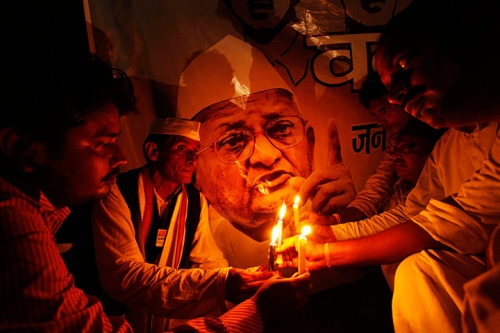2011-08-21 Massive anti-corruption movement grows in #India

Millions of Indians pour out into the streets as arrest of 74-year old anti-corruption activist Anna Hazare and 2,600 supporters backfires.
Attempts by the Indian government to crack down on a budding anti-corruption movement in the country have backfired. After Tuesday’s arrest of some 2,600 protesters, including the high-profile anti-corruption activist Anna Hazare, millions of Indians poured out into the streets to fight for a strong anti-corruption law.
The 74-year old Hazare, whose struggle is deeply inspired by Mahatma Gandhi, had wanted to stage an indefinite hunger strike in a park in New Delhi, vowing to “fast until death” unless the government accepted the movement’s demand to create an independent anti-corruption agency with sweeping powers, a so-called Lokpal, or ombudsman.
Hazare (bio), a decorated former army officer who after a near-death experience at the age of 26 decided to dedicate his life to humanity, has been fighting against the endemic corruption in India’s political establishment for years. Earlier this year, he fasted and managed to force the government into including his movement in the drafting of a new anti-corruption bill. Eventually, the proposed bill ended up being charade, covering less than 0.5% of India’s officials.
According to the best-selling Indian writer Chetan Baghat:
[Hazare's] non-violent yet aggressive, Gandhi-like method of protest, together with his anti-corruption cause, struck a chord with Indians. Thousands of non-government organisations fight for social causes every day in India, but none has ever achieved this kind of support. From rickshaw drivers to software engineers, from businessmen to spiritual leaders, people from all walks of life back Anna. So do I.
In a serious lapse of judgment, the government arrested Anna from his home on the morning of 16 August. News spread, and the nation exploded on to the streets. By evening, the government wanted to release him. In a masterstroke, Anna refused to come out of jail, and continued his fast there. The country is in a frenzy, and the government is in a fix.
Indeed, Mohan Guruswamy, the founder of the Centre for Policy Alternatives, said that “what you are seeing on the street is a middle-class rebellion.” Channel 4 even called the country’s anti-corruption protests a ‘new consciousness’, quoting one man as saying that ”there is a new generation with a global consciousness of what is happening.”
As the New York Times reported:
Fueled by obsessive coverage on India’s all-news television networks, [Hazare's] jailhouse protest had clearly captured the imagination of the country, and appeared to back government leaders into a political corner. Elsewhere in India, protests were held in major cities, as well as in villages and across many states.
Corruption is a source of growing public anger and frustration in India, as well as a yoke threatening to drag down the national coalition government led by the Indian National Congress Party. Mired in scandals for months, Congress Party leaders have attempted to convince the public that they are cracking down on corruption, yet public skepticism remains high.
As the Indian journalist Seema Sengupta wrote:
Once conferred with the third-highest civilian honour of the land, he has now been arrested and is facing the wrath of the ruling Congress party for his effort to retrieve Gandhi’s legacy of nonviolence at a time when India is struggling to fetter the home-bred rebellions shattering the nation’s tranquillity.
Short-changed by the ruling establishment, India’s modern-day Gandhi threatened a fast unto death. The public, livid at the government’s pernicious attempt to defame a person who has appropriated the most potent symbol of nationalism in Indian history took to the streets in vast numbers. Irked by administrative apathy towards the widespread abuse of authority, people on the street are now desperate to unearth the reason for a ruthless assault on civil liberties. What prompted this sudden high-handedness? Who is behind the orchestrated smear campaign against the anti-corruption activists?
Hazare and his supporters have become a sting in the side of the Indian establishment. A spokesman for the ruling Congress party claimed that Hazare was surrounded by “armchair fascists, overground Maoists, closet anarchists”. As the New York Times reported:
His incarceration has been a major political crisis forIndia’s national government, especially after Mr. Hazare rejected a government offer to release him on Tuesday night. He refused because the release was contingent on his agreement to limit the scale and length of his hunger strike, terms he declined to accept. With pressure mounting, a deal was reached early Thursday morning under which Mr. Hazare agreed to limit his protest to 15 days and the police lifted any restrictions on the size of his crowd.
The Associated Press quoted Shanti Bhushan, a former government minister who is now helping to lead the protests, as saying that “it is for the first time that the people of this country are feeling empowered. They are feeling that we are no longer slaves. We are citizens of a free country. Our voice carries importance.”
Another man, a simple 47-year old milk salesman who had commuted from the suburbs with 15 others to join the protests, echoed Bhushan’s conclusions. “Everybody is fed up with corruption,” he said. “Here, I see some rays of hope. By coming here, I want to shake the system. Maybe something positive will come out of this.”
Addendum, via NYT: Having trumped a government effort to defuse his anticorruption movement, the protest leader Anna Hazare announced that he would leave a city jail on Friday and begin a mass demonstration and hunger strike at a public ground in the national capital.